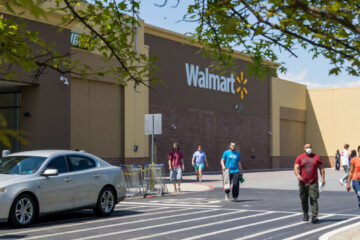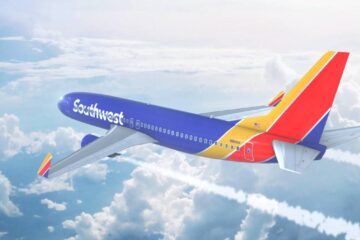What’s all the noise about?
If you live in San Francisco’s South of Market neighborhood, you might have heard the racket from the seemingly ceaseless honking of autonomous vehicles.
Related: Analyst updates Tesla stock forecast before October’s key event
Specifically, we’re talking about Alphabet-backed (GOOGL) Waymo robotaxis that have been blasting their horns in a parking lot in the middle of the night.
Waymo’s signature white Jaguars are programmed to honk when they sense a nearby car that might reverse into them.
A Waymo spokesperson said the company updated the software, which “should keep the noise down for our neighbors moving forward.”
Autonomous vehicles have been making all kinds of noise in their slow, often bumpy ride to mainstream acceptance.
Nevertheless, a study by the Autonomous Vehicle Industry Association released in April found that AVs have driven nearly 70 million miles on public U.S. roads, which is equivalent to 293 round trips to the moon or driving across Route 66 over 29,000 times.
“From trucks to robotaxis to zero-occupancy delivery vehicles, we’re seeing a 59% increase in autonomous miles driven since we last reported this figure nine months ago, which is proof of the industry’s growth and success,” Jeff Farrah, the group’s CEO, said. “And this number is growing every day.”
Motorists, on the other hand, don’t appear to be feeling any kind of love for robotic rides. An American Automobile Association survey found nine out of ten drivers were either fearful or uncertain about riding in fully self-driving vehicles.
Dara Khosrowshahi, chief executive officer of Uber Technologies Inc. Photographer: David Paul Morris/Bloomberg via Getty Images
Uber CEO: we’re ‘indispensable partner for AV players’
“Recently, there have been several well-publicized incidents where AV technology has fallen short, and that naturally makes some people leery about turning over complete control to the system,” AAA Idaho public affairs director Matthew Conde said in a statement.
“An incremental rollout of proven technologies will be key to getting drivers more comfortable with the idea of a fully self-driving car,” he added.
Related: Analyst revisits Tesla stock price target with eye on key value driver
Despite fears and technical headaches, companies are still going ahead with their autonomous vehicle plans.
Tesla (TSLA) is scheduled to unveil its Robotaxi on Oct. 11, after the world’s largest electric vehicle maker scrubbed the original Aug. 8 event.
Last month, Amazon-owned (AMZN) autonomous vehicle company Zoox announced that Austin, Texas, will be its fourth public testing site. Cars will also drive around in Miami, Seattle, Las Vegas, and San Francisco Bay.
On Aug. 22, Cruise, a General Motors (GM) AV company, and ride-hailing platform Uber (UBER) jointly announced a multi-year partnership that will kick off next year and allow Uber riders to choose a trip using a Cruise autonomous vehicle.
Uber has been offering driverless cars in Phoenix on its platform since October through a partnership with Waymo. Waymo has about 700 vehicles in its fleet and is the only U.S. firm operating an uncrewed robot axis that collects fares, according to Reuters.
“Cruise is on a mission to leverage driverless technology to create safer streets and redefine urban life,” said Marc Whitten, Cruise CEO, in a statement. “We are excited to partner with Uber to bring the benefits of safe, reliable, autonomous driving to even more people, unlocking a new era of urban mobility.”
Uber CEO Dara Khosrowshahi said his company “can play an important role in helping to safely and reliably introduce autonomous technology to consumers and cities around the world.”
Khosrowshahi hinted at the partnership in the company’s recent earnings call when he said Uber was “in late-stage discussions with additional global AV players to join our platform, and we’ll have more announcements in the coming weeks and months.”
“Uber can provide enormous demand without AV players needing to invest capital toward acquiring customers or building the marketplace tech that delivers reliability at the standard that consumers have come to expect,” he told analysts on Aug. 6. “That’s all to say that Uber will be an indispensable partner for AV players of all sorts.”
In a recent interview, Khosrowshahi expressed reservations about Telsa’s plan, saying it was “not clear” to him that the average Tesla owner would want to have their car “ridden in by a complete stranger.”
He also said that allowing Tesla owners to rent out their cars for taxi services will make managing the “peaks and valleys” associated with supply and demand difficult.
Cruise is doing supervised testing– where the AV is fully driving itself, but a human safety driver is behind the wheel–in Phoenix, Dallas, and Houston
California authorities revoked Cruise’s permit to operate driverless vehicles in October after one of its robotaxis struck a pedestrian after she was hit by another vehicle and dragged her 20 feet.
Meanwhile, the National Highway Traffic Safety Administration closed one of two investigations into the performance of Cruise vehicles after the company agreed to do a recall.
The administration said in filings posted on its website that it had analyzed 7,632 reports of hard braking and found 10 crashes with four injuries. No crashes were associated with inappropriate stopping.
Analyst: AV competition good for Uber
Cruise agreed to recall all 1,194 of its robotaxis for unexpected braking and said it fixed the problem with a software update.
The company said it did not agree with NHTSA’s conclusion that a recall was needed but had agreed to do so to resolve the investigation.
More Automotive:
Toyota Crown is a masterclass in cheap, quiet luxuryFord making radical change that might anger loyal consumersNissan’s latest tech takes on a problem every driver faces
NHTSA is still investigating reports that Cruise vehicles encroached on pedestrians present in or entering roadways, including crosswalks.
Cruise’s CEO resigned last year, and GM subsequently announced plans to scale back spending on self-driving units.
Several analysts released research reports following news of the Uber-Cruise partnership.
Bank of America Securities analyst Justin Post said the addition of Cruise “reinforces the concept” that fleet operators, or eventually individual AV owners, will want to leverage Uber’s demand aggregation to increase asset utilization.
Post, who has a buy rating and $88 price target on Uber shares, said that AV competition is “good for potential long-term Uber partnership economics” and argued that Tesla and Amazon’s AV investment “could be a long-term net positive”
RBC Capital kept an outperform rating on GM after announcing the multiyear strategic partnership.
The news affirms RBC’s contention that Tesla will be one robotaxi player among others even in the U.S. and highlights the value of the Uber App, the firm said
RBC said it assumed that the vast majority of robotaxi revenues will come from an “assortment of players,” not just Tesla. The news also affirms GM’s commitment to autonomy, “which we applaud,” the firm said.
GM shares “rarely get credit” for Cruise, and RBC analysts wondered if this could change, especially with all the fanfare surrounding Tesla’s robo-taxi unveil on October 10.
KeyBanc analyst Justin Patterson said Uber’s partnership with Cruise brings another large autonomous vehicle operator onto Uber’s platform and gives Uber users in new geographies access to autonomous vehicles.
Patterson said that he views this as a positive indication of Uber’s value to autonomous vehicle companies, establishing a hybrid ride services network, and likely the first of several announcements Uber alluded to on its Q2 earnings call.
The analyst maintained that investors are skeptical Uber can partner with Tesla but pointed to past partnerships as a sign the companies can work together.
He said that he remains “open-minded” going into Tesla’s upcoming October 10 event.
Related: Veteran fund manager sees world of pain coming for stocks


